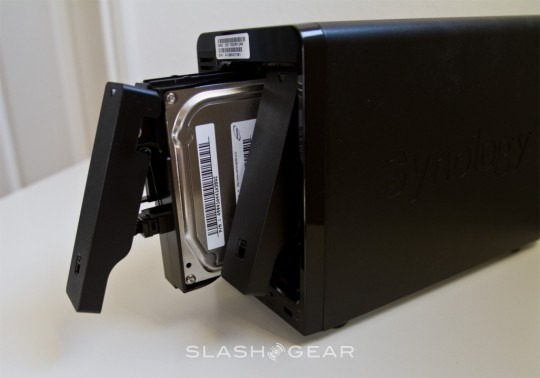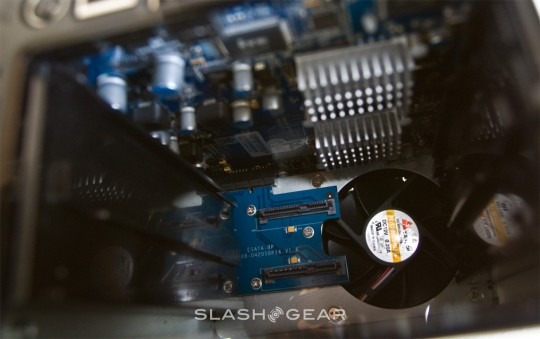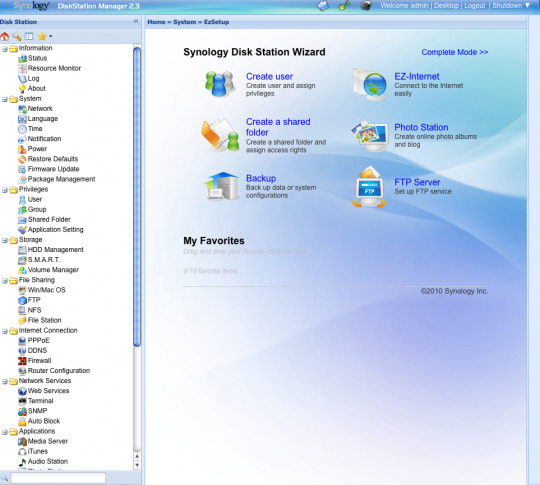Synology DS710+ NAS Review
Synology have made a name for themselves in the network-attached storage segment for sturdy hardware, comprehensive software and decent performance, the the company are hoping to deliver all three once again with the DiskStation DS710+. A dual-drive RAID array with some ambitious throughput promises, the DS710+ also gets a fairly premium price tag too; check out the full SlashGear review after the cut.
In the box there's the DS710+ itself, along with the AC adapter, screws to fix your hard-drives into the caddies, a Quick Start manual and warranty guide, installation CD and an ethernet cable. Accessories are packaged in a separate box to the NAS itself, and everything arrived scratch-free. The front of the DS710+ has a column of LEDs – for status, LAN, HDD1, HDD2 and eSATA activity – together with a power button (and LED); there's also a USB 2.0 port, for plugging in a memory stick or memory card reader, complete with a "copy" button that automatically grabs the contents to a preset directory.

The back panel is dominated by the two HDD caddies, which are made of reasonably sturdy plastic and held in by simple clips; it's an easy matter to disengage them and slide them out, though of course you'll need a screwdriver to actually add/remove the drives themselves. As for ports, there are two USB 2.0, a gigabit ethernet, power and an eSATA connection, along with a Kensington lock hole, reset button and a blanked-off VGA port. The latter appears to be a legacy of the mainboard Synology have used, which is based on a 1.67GHz Intel Atom processor paired with 1GB of memory. Only one fan is fitted, a standard 80mm unit at the front, though while the textured front panel looks like it could be a fan grill it's actually solid plastic; instead the DS710+ sucks in air through an array of holes at the bottom front edge.

Setup is straightforward; Synology provided us with a pair of 750GB Samsung HD753LJ hard-drives, which quickly screwed into the plastic caddies and slotted into place. While the temptation is to ignore the installation CD, it's actually pretty important; it downloads the latest version of the DiskStation Manager firmware (DSM) and installs it, a process which takes a few minutes. The advanced setup allows you to specify a fixed IP address and rename the NAS, but once that's all done the rest of the setup is completed via the web interface.
First stop is the Storage section, where you can choose from the various RAID setups on offer: Basic, JBOD, RAID 0 or RAID 1. With only two internal drive bays there's obviously nothing more complex than simple mirroring, but you can add extra external RAID 1 drives using the ports on the rear. We picked RAID 1 and then had to wait a few hours while the array was established; of course, after you've done that you can subsequently replace one of the drives with the DS710+ still running and have it automatically repair the array. That's made a little trickier by the rear-access to the dual caddies, but it's unlikely to be something you'll be attempting often.
Synology's current DSM release is version 2.2, and there's a long list of potential functionality depending on how much or how little you expect from your NAS. Obviously there's basic network-access and backup, and you can create various partitions and directories, user and group accounts and the typical access restrictions (read, read/write, etc). Given the small office focus of the DS710+ you can set the NAS to automatically email new users with access instructions, together with sending out status messages to whoever is logged as administrator.
From there, though, the sky is the limit. The DS710+ can act as a UPnP/DLNA or iTunes media server, squirting out audio, video and image content across your network, and as a standalone BitTorrent download station. You can use it to host a website (with MySQL and PHP support) or merely as an FTP site, with an optional AJAX-based file and photo browser and support for smartphone access (iPhone OS 2.2.1 or later; WM 6.0 or later, Symbian OS 9.1 or S60 3rd Ed or later). You can plug a printer into one of the USB 2.0 ports and share that over the network, or use the DS710+ to store recorded video from up to sixteen IP cameras. There's even a standalone media player app, which lets you plug in a set of USB speakers and control audio playback directly from an app in the web interface. Best of all, the vast majority of the interface is clear and straightforward, with little in the way of hurdles to get things up and running, and if you disable certain functionality then the menu generally is hidden so as to avoid confusing matters.

Just around the corner, however, is DSM 2.3 – currently in beta – and that adds even more flexibility. Recognizing that many users want offsite backup along with local storage, DSM 2.3 introduces support for Amazon S3, the company's subscription-based cloud storage service. There's also a new iPhone app called DS Cam, with the ability to remotely watch live IP CCTV footage managed by the DS710+, and Synology have made improvements to the onboard media player and AJAX photo browser too. Of course, if you're relying on the DS710+ for your sole backup you might not want to put all your faith in the DSM 2.3 beta, but it's an interesting taste of what's to come.
A NAS with poor performance is of no use to anybody, and so we're pleased to report that the DS710+ suffers no such shortcomings there, either. We used our gigabit ethernet network to transfer a 1.4GB file from a Mac Pro workstation to the DS710+, a process which took around 115 seconds (just under two minutes) in RAID 1 configuration and 102 seconds in RAID 0 configuration. Copying back that same file from the DS710+ to our Mac Pro took longer, however, at around 205 seconds (just under three and a half minutes) for RAID 1 configuration and 182 seconds in RAID 0 configuration.
The biggest problem we have with the Synology DS710+ is the price. Diskless, you can pick up the NAS for around $560, while a pre-configured DS710+ 2100 with twin 1TB drives will set you back around $860. That's a serious step up from other dual-drive models in Synology's own range, which actually run the same software (and so have the same feature list). Yes, the DS710+ is a speedy performer, but you really have to need that extra speed advantage in order to pick it. Still, make the investment and you'll have a strong performer with bags of flexibility.
Quick Look Video
[vms ad1024ac95c3b208610d]
